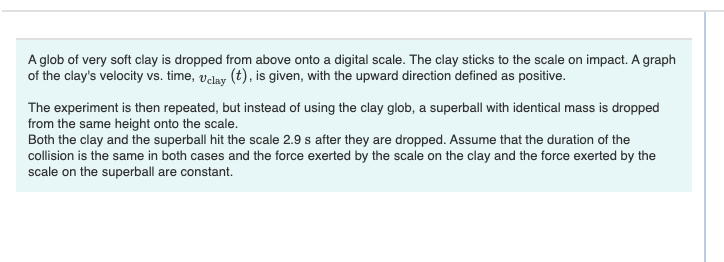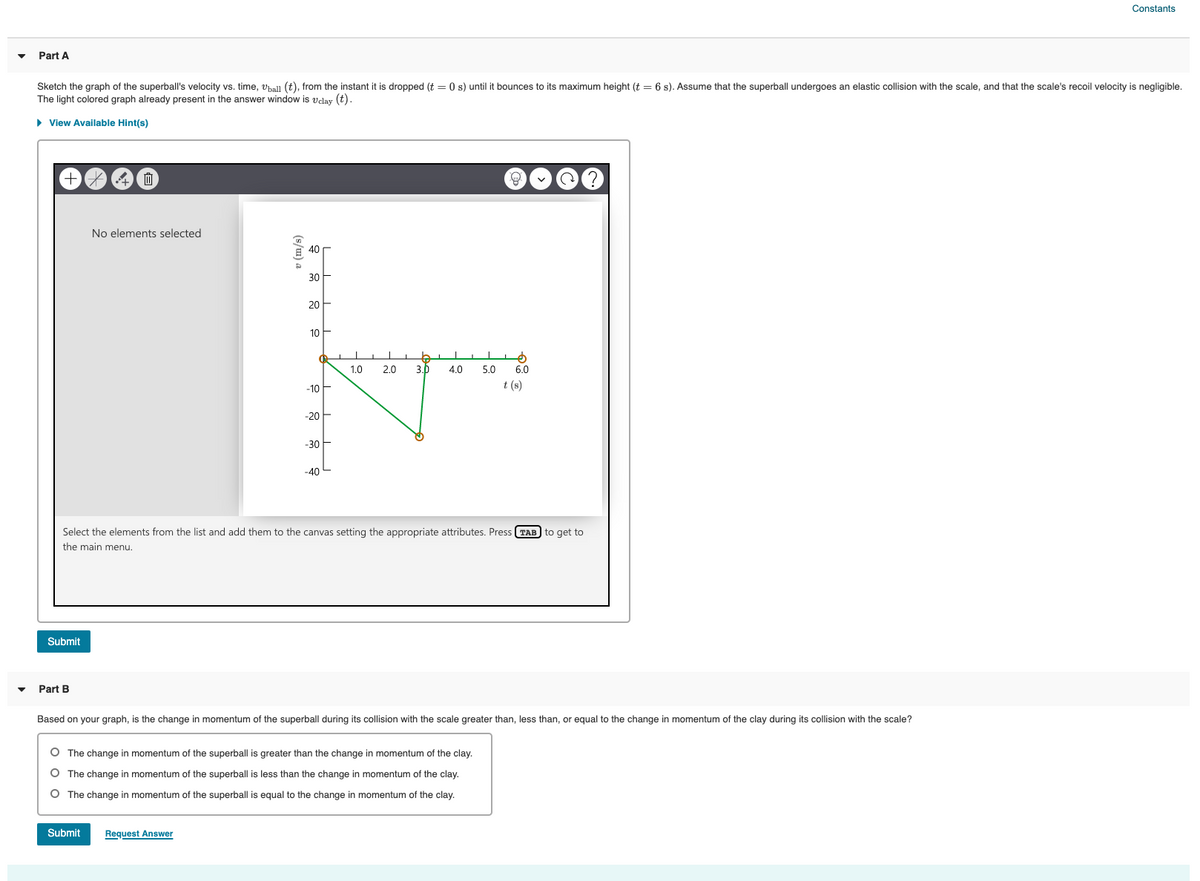• Part A Sketch the graph of the superball's velocity vs. time, vball (t), from the instant it is dropped (t = 0 s) until it bounces to its maximum height (t = 6 s). Assume that the superball undergoes an elastic collision with the scale, and that the scale's recoil velocity is negligible. The light colored graph already present in the answer window is vday (t). > View Available Hint(s) + No elements selected 30 20아 10 1.0 2.0 3.5 4.0 5.0 6.0 -10- t (s) -20 -30F -40 Select the elements from the list and add them to the canvas setting the appropriate attributes. Press TAB to get to the main menu. Submit Part B Based on your graph, is the change in momentum of the superball during its collision with the scale greater than, less than, or equal to the change in momentum of the clay during its collision with the scale? O The change in momentum of the superball is greater than the change in momentum of the clay. O The change in momentum of the superball is less than the change in momentum of the clay. O The change in momentum of the superball is equal to the change in momentum of the clay. Submit Request Answer
• Part A Sketch the graph of the superball's velocity vs. time, vball (t), from the instant it is dropped (t = 0 s) until it bounces to its maximum height (t = 6 s). Assume that the superball undergoes an elastic collision with the scale, and that the scale's recoil velocity is negligible. The light colored graph already present in the answer window is vday (t). > View Available Hint(s) + No elements selected 30 20아 10 1.0 2.0 3.5 4.0 5.0 6.0 -10- t (s) -20 -30F -40 Select the elements from the list and add them to the canvas setting the appropriate attributes. Press TAB to get to the main menu. Submit Part B Based on your graph, is the change in momentum of the superball during its collision with the scale greater than, less than, or equal to the change in momentum of the clay during its collision with the scale? O The change in momentum of the superball is greater than the change in momentum of the clay. O The change in momentum of the superball is less than the change in momentum of the clay. O The change in momentum of the superball is equal to the change in momentum of the clay. Submit Request Answer
Glencoe Physics: Principles and Problems, Student Edition
1st Edition
ISBN:9780078807213
Author:Paul W. Zitzewitz
Publisher:Paul W. Zitzewitz
Chapter9: Momentum And Its Conservation
Section9.1: Impulse And Momentum
Problem 2PP
Related questions
Question
Can i get help with these problems

Transcribed Image Text:A glob of very soft clay is dropped from above onto a digital scale. The clay sticks to the scale on impact. A graph
of the clay's velocity vs. time, velay (t), is given, with the upward direction defined as positive.
The experiment is then repeated, but instead of using the clay glob, a superball with identical mass is dropped
from the same height onto the scale.
Both the clay and the superball hit the scale 2.9 s after they are dropped. Assume that the duration of the
collision is the same in both cases and the force exerted by the scale on the clay and the force exerted by the
scale on the superball are constant.

Transcribed Image Text:Constants
Part A
Sketch the graph of the superball's velocity vs. time, vhall (t), from the instant it is dropped (t = 0 s) until it bounces to its maximum height (t = 6 s). Assume that the superball undergoes an elastic collision with the scale, and that the scale's recoil velocity is negligible.
The light colored graph already present in the answer window is vdlay (t).
• View Available Hint(s)
No elements selected
E 40
30
20
10
1.0
2.0
3.b
4.0
5.0
6.0
-10
t (s)
-20
-30
-40
Select the elements from the list and add them to the canvas setting the appropriate attributes. Press (TAB to get to
the main menu.
Submit
Part B
Based on your graph, is the change
momentum of the superball during its collision with the scale greater than, less than, or equal to the change in momentum of the clay during its collision with the scale?
O The change in momentum of the superball is greater than the change in momentum of the clay.
O The change in momentum of the superball is less than the change in momentum of the clay.
O The change in momentum of the superball is equal to the change in momentum of the clay.
Submit
Request Answer
(s/u) a
Expert Solution
This question has been solved!
Explore an expertly crafted, step-by-step solution for a thorough understanding of key concepts.
This is a popular solution!
Trending now
This is a popular solution!
Step by step
Solved in 2 steps with 9 images

Knowledge Booster
Learn more about
Need a deep-dive on the concept behind this application? Look no further. Learn more about this topic, physics and related others by exploring similar questions and additional content below.Recommended textbooks for you

Glencoe Physics: Principles and Problems, Student…
Physics
ISBN:
9780078807213
Author:
Paul W. Zitzewitz
Publisher:
Glencoe/McGraw-Hill

University Physics Volume 1
Physics
ISBN:
9781938168277
Author:
William Moebs, Samuel J. Ling, Jeff Sanny
Publisher:
OpenStax - Rice University

Principles of Physics: A Calculus-Based Text
Physics
ISBN:
9781133104261
Author:
Raymond A. Serway, John W. Jewett
Publisher:
Cengage Learning

Glencoe Physics: Principles and Problems, Student…
Physics
ISBN:
9780078807213
Author:
Paul W. Zitzewitz
Publisher:
Glencoe/McGraw-Hill

University Physics Volume 1
Physics
ISBN:
9781938168277
Author:
William Moebs, Samuel J. Ling, Jeff Sanny
Publisher:
OpenStax - Rice University

Principles of Physics: A Calculus-Based Text
Physics
ISBN:
9781133104261
Author:
Raymond A. Serway, John W. Jewett
Publisher:
Cengage Learning

Classical Dynamics of Particles and Systems
Physics
ISBN:
9780534408961
Author:
Stephen T. Thornton, Jerry B. Marion
Publisher:
Cengage Learning